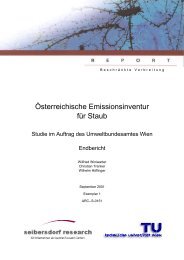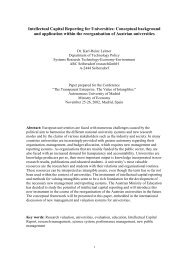ALPMON FINAL REPORT - ARC systems research
ALPMON FINAL REPORT - ARC systems research
ALPMON FINAL REPORT - ARC systems research
You also want an ePaper? Increase the reach of your titles
YUMPU automatically turns print PDFs into web optimized ePapers that Google loves.
Contract ENV4-CT96-0359 <strong>ALPMON</strong><br />
as proposed by Sandmeier and Itten, 1997, is strongly recommended. Unfortunately, no such software<br />
is available in public up to now.<br />
In summary, one can say that from visual interpretation application of the described atmospheric<br />
correction algorithms in general cannot be recommended. However, the new ATCOR 3 program<br />
(Richter, 1998) seems to solve some of the problems addressed above.<br />
2.2.5 Data Preparation (WP8)<br />
Today’s remote sensors offer a wide variety of image data with different geometric, radiometric and<br />
spectral resolution characteristics. Although the information content of these images might be partially<br />
overlapping the complementary aspects represent a valuable improvement for information extraction.<br />
To exploit the entire content of multi-sensoral image data appropriate techniques for image fusion are<br />
indispensable. Within <strong>ALPMON</strong> two methods were applied that allow the inclusion of features derived<br />
from very high resolution panchromatic images into multi-spectral classification. The first method uses<br />
object edges from the panchromatic image to sharpen the multi-spectral image, the second method<br />
computes texture images to be used as additional bands in classification.<br />
Image Fusion<br />
Examining existing methods for fusion of panchromatic and multi-spectral images, the most common<br />
approaches are pixel based techniques. These techniques apply numerical combinations of pixel<br />
values (spectral reflectance values), and are often referred to as image merging (Chavez et al. 1991).<br />
They include Intensity-Hue-Saturation and Principal Component substitution merging, linear<br />
combinations and multiplication of image bands. A comprehensive review on these techniques can be<br />
found in Pohl (1996). All these methods enhance the local texture of the multi-spectral image, thus<br />
improving the visual interpretability of the fusion results. At the same time they distort the spectral<br />
properties of the multi-spectral bands by combining spectral reflectance values of different image<br />
bands.<br />
In order to avoid the spectral distortion it is necessary to perform image fusion on a higher level of<br />
abstraction. Instead of using the spectral reflectance values represented in the single pixels, the fusion<br />
process can be based on image features, such as edges or segments. Within the project a new<br />
approach was developed, applying adaptive filters for feature based image fusion.<br />
The conclusions drawn from the application in the test sites are manifold. The adaptive image fusion<br />
(AIF) is considered useful for areas, that are dominated by objects larger than the low resolution pixel<br />
size. Taking the average pixel size of today’s multi-spectral sensors (20 – 30m) this prerequisite is only<br />
true for certain types of image objects. Due to the size and heterogeneity of the single objects, this<br />
does not hold for forest areas. There the AIF leads to a loss of details caused by averaging the multispectral<br />
pixels, which is due to missing information in the panchromatic image. However, for the<br />
segmentation of forest and non forest areas the approach is considered valuable. One suggestion was<br />
to use the fusion result for first level classification, i.e. classification of meta classes that can be used<br />
as masks for detailed classification. The advantage of this approach lies in the sharp delineation of the<br />
objects to be classified, thus leading to less misclassifications caused by mixed pixels. The approach<br />
has been used successfully for delineation of the forest border in the Dachstein test site.<br />
A second suggestion was the combination of AIF and substitution techniques for visualisation. AIF<br />
would then sharpen object edges and thus eliminate the blocky pixel structure of the low resolution<br />
image. Next the local texture could be added by applying a substitution technique onto the AIF<br />
processed image, thus leading to a sharpened high resolution multi-spectral image product. However,<br />
this product is not considered an appropriate input for numerical classification but offers an excellent<br />
visual impression of the area. The latter approach was successfully applied to the Tarvisio test site.<br />
Texture Features<br />
Very high spatial resolution panchromatic images contain a large amount of objects. In order to<br />
recognise these objects the human visual system does not only rely on the intensity of single pixels but<br />
on the spatial variation of these intensities, in general called texture. In contrast to the parameter tone,<br />
which is defined by the intensity of a single pixel, texture has a higher degree of dimension. This<br />
degree is not limited by the two dimensions of the image matrix but also includes the different<br />
characteristics of texture. Using human language texture might be described as rough, smooth,<br />
granular or by similar expressions. But these lingual descriptions lack a formal definition of texture.<br />
Therefore most methods for its characterisation are based on the intuition and perception of the<br />
JR, RSDE, ALU, LMU, Seibersdorf, WSL 21




